SEO
The Complete Guide To Google Ads Lead Forms Extensions

In the past 12 months, mobile web traffic has surpassed desktop traffic.
As consumers use multiple devices to browse the internet, they expect a seamless experience across devices.
That’s why focusing on user experience is crucial to any business’s success.
Google originally announced its lead form assets (formerly known as extensions) in 2019 – and today, they are available for many campaign.
How can you make the most of the opportunities and benefits that Google Ads lead forms provide?
Read on to learn how lead forms work, the pros and cons of using them, what you need to get started, how to set them up, and more.
What Are Google Lead Form Assets?
Per Google’s definition, “Lead forms help you generate leads by letting people submit their information in a form directly in your ad.”
A lead form asset can be created in your current Google Ads account, attaching it to the desired campaign.
When your audience interacts with your ad that contains the ad asset, they are prompted to input their information in the form instead of being directed to your company website.
Who Should Use Google Lead Form Assets?
Lead form assets can benefit most B2B companies or any business that is looking to generate leads.
Additionally, if your company does not have the resources (time, expertise, money) to improve the website experience, Google lead form assets may be for you.
Lead form assets are available for the following campaign types:
- Search.
- Discovery.
- Display.
- Video (currently in beta).
Google lead form assets work in different ways depending on the campaign type.
- Search: Lead forms can appear on mobile and desktop devices.
- Discovery: At least one Discovery image ad is required for lead forms to serve. They are not compatible with carousel ads.
- Display: Lead forms can appear on both mobile and desktop devices. At least one responsive display ad is required for lead forms to serve.
- Video: Lead forms are only available on mobile Android devices at this time. If a campaign is targeting iOS and desktop users, the campaign won’t serve those users.
Pros And Cons Of Lead Form Assets
As with every tool or feature, it’s important to weigh the benefits and drawbacks. Let’s take a look at lead form assets specifically.
Pros Of Lead Form Assets
- Easy to set up.
- Ability to download leads directly from Google Ads.
- Great way to gain first-party data.
- Easier user experience if the company’s mobile site is less than stellar.
- Available for campaign types at all areas of the customer funnel.
Cons Of Lead Form Assets
- Harder to automate lead sharing with customer relationship management (CRM).
- Traffic does not lead to your website.
- Attribution can be difficult.
- Must spend more than $50,000 over the lifetime of the ad account to qualify.
- Lead form assets work differently for each campaign type.
Lead Form Asset Requirements
Currently, lead form assets are allowed on Search, Display, and Discovery ad types. They are currently in beta for Video ads.
To get whitelisted for the Video ad type beta, please contact your Google rep.
There are a few requirements in order to qualify for using this asset type:
- A good history of compliance policy with Google.
- Be in an eligible vertical or sub-vertical.
- A privacy policy for your business.
- Over $50k lifetime spend in Google Ads (for lead forms in Discovery, Display, or Video campaigns).
Google lead form assets are not allowed in all verticals. Some vertical exclusions include:
- Sensitive verticals (such as sexual content).
- Sub-verticals of sensitive verticals.
- Affiliate networks. Only first-party advertisers or third-party agencies are permitted to run lead form assets.
Lead form assets are only eligible to serve in specific countries. If an ad is served to an audience in an ineligible country, they will not be able to view the lead form.
Currently, lead form assets are available in the following countries:
How To Set Up Lead Form Assets
Creating a new lead form asset doesn’t require a ton of extra time or effort.
You have the option to create a new asset at the account level, within an existing campaign, or while creating a new one.
For existing campaigns, click into the campaign and then Ads & Assets on the left-hand side. Select Lead form within the asset section. Click the blue “+” sign to create a new lead form asset.
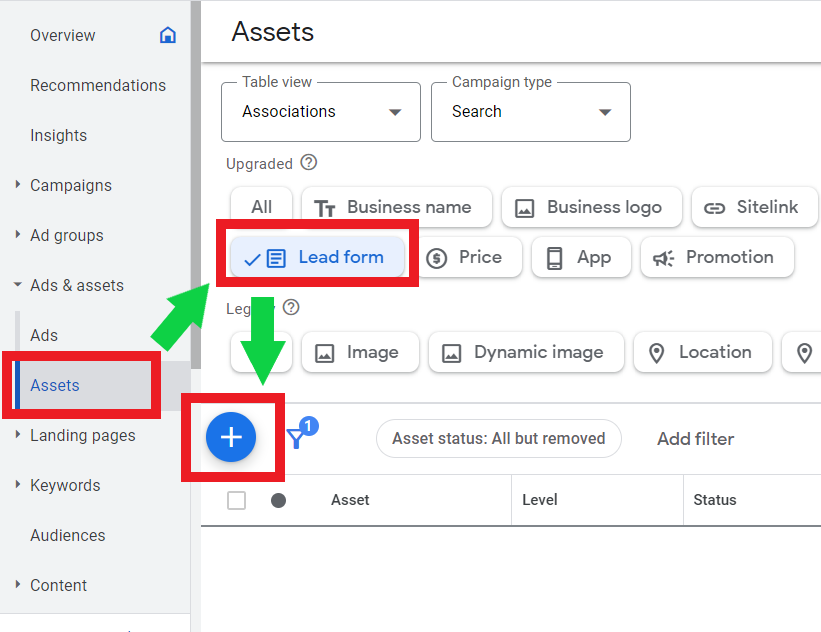
The next step is to add a headline, description, and business name. These fields are required.
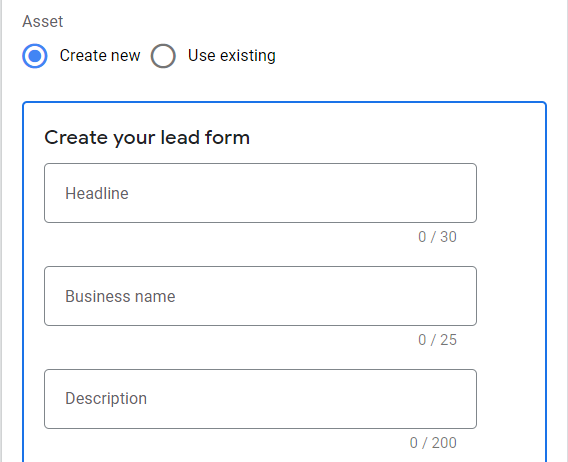
From there, you can now choose the questions you’d like the user to answer in your form. You will need to select at least one option to continue.
Don’t forget the required privacy policy URL to link to!
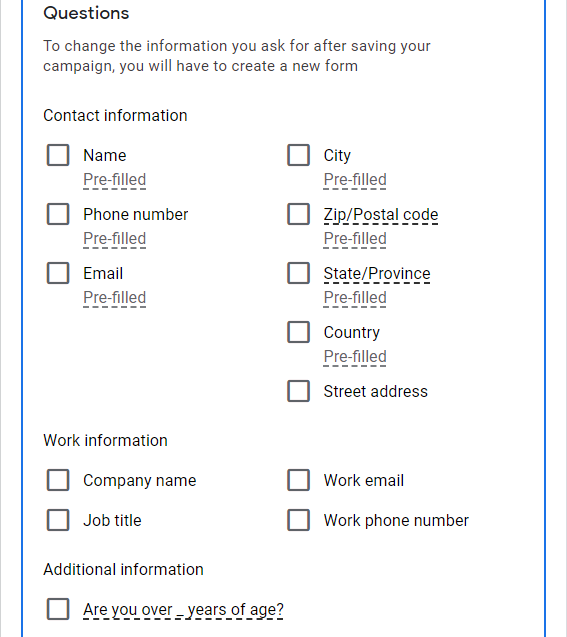
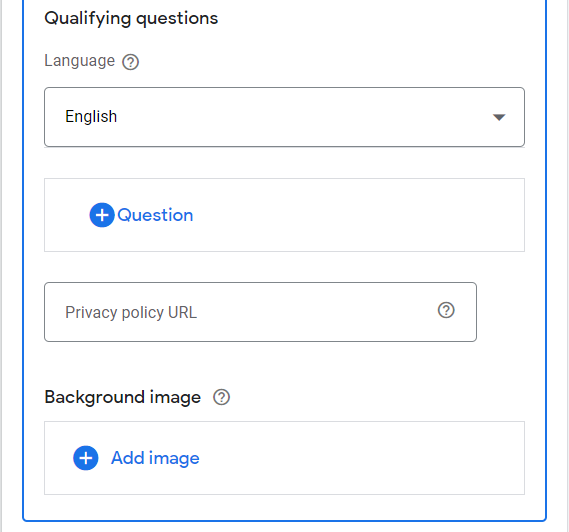 Screenshots taken by author, Google Ads, June 2023
Screenshots taken by author, Google Ads, June 2023Google also provides qualifying questions in many verticals to gain as much information as you need for qualified leads. These qualifiers are broken down by:
- Auto.
- Business.
- Education.
- General.
- Insurance.
- Jobs.
- Real estate.
- Retail.
- Technology.
- New questions.
Examples of qualifying questions in the auto industry include:
- When do you plan on purchasing a vehicle?
- Which vehicle make are you interested in?
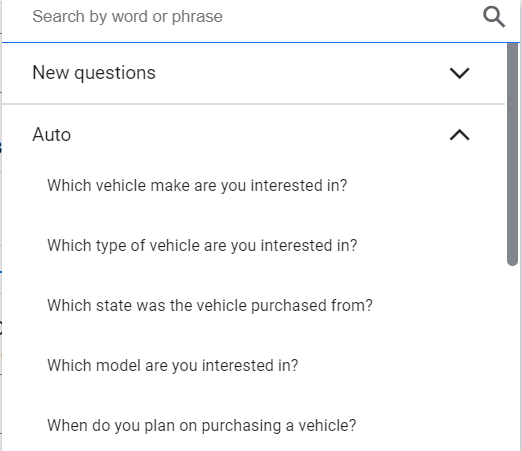 Screenshot taken by author, Google Ads, June 2023
Screenshot taken by author, Google Ads, June 2023If utilizing lead form assets for Search, you then need to provide a background image in the aspect ratio of 1.91:1.
Lastly, you’ll need to create the submission message after a user successfully fills out the form.
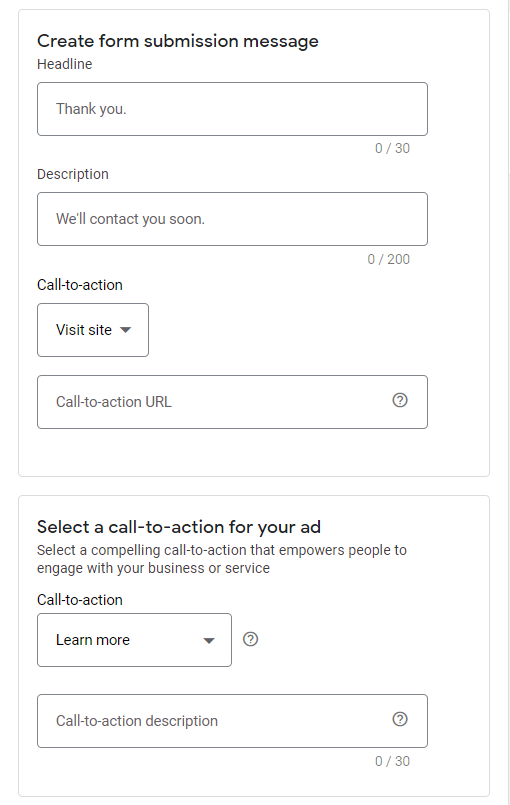 Screenshot taken from author, Google Ads, June 2023
Screenshot taken from author, Google Ads, June 2023Optimizing Lead Form Assets
Now that your lead form has been created, you have the option to optimize for the following options:
- Lead volume.
- Lead quality
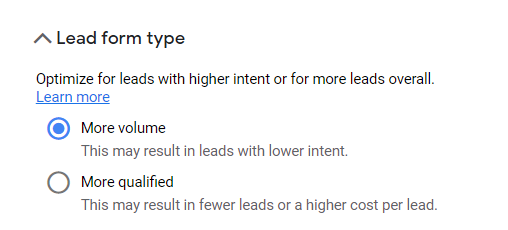 Screenshot taken by author, Google Ads, June 2023
Screenshot taken by author, Google Ads, June 2023How do you know which option to choose? This decision should be made solely on the business goals and intention of the campaign.
If the goal is to capture as many leads as possible (top or middle of funnel), optimizing for lead volume would be your best option.
As a word of caution, this option may get you less qualified leads.
If the goal is to spend dollars as efficiently as possible to get the most qualified leads, then optimizing for more qualified should be chosen.
This option will get you better quality but at a potentially higher cost per lead (CPL) and fewer leads overall.
Using Lead Form Assets With Smart Bidding
If using Google lead form assets, campaigns must use a conversion-focused Smart Bidding strategy.
The campaign must include a Google lead form conversion goal to be optimized towards, even if the campaign is optimizing toward other types of conversions.
Reviewing Lead Form Data
This section may be the most important, as it deals with reading and analyzing your lead submission information.
Google currently gives you two options to capture your leads:
- Manually download them from the interface.
- Create a webhook integration to automatically import lead data into a CRM.
If manually downloading leads, keep in mind that Google only allows downloads within 30 days of submission. After that, the data is gone. For this reason, it is crucial to monitor incoming leads to ensure a prompt follow-up.
Google also provides the option to automatically export lead form data for up to 60 days to a CRM using Google Ads API.
Creating A Webhook Integration
Let’s face it – you could be spending your time more wisely than manually downloading leads every day.
This is why creating that webhook integration is recommended to import data to your CRM.
While more valuable and efficient in the long run, this option will take some integration time to set up. If your team has the ability and resources on the staff (or agency) to create the webhook, you can generate a webhook and key to pass data.
For more information on this setup, visit Google’s official support page.
The basic process looks like this:
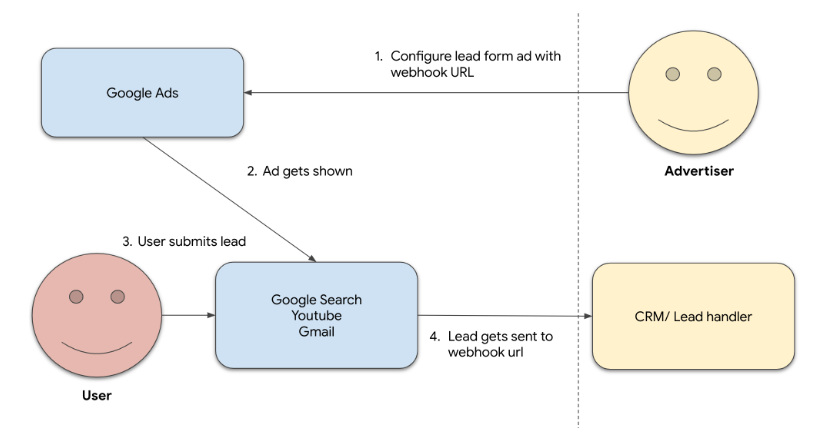 Screenshot from Google Developers, June 2023
Screenshot from Google Developers, June 2023Now, if you do not have the capabilities on your team to create a webhook URL and key, you still have options.
Google allows a third-party integration, Zapier, to help integrate leads seamlessly.
Zapier is a cost-effective way to take the hassle out of more complex technical solutions needed to successfully automate your lead nurturing process. To sign up for a Zapier account, visit here.
Lastly, once the webhooks have been set up, it’s time to verify the data. This step should never be skipped to ensure your automated solutions are working!
If you took the time to set up the integration, make sure that it’s working for you.
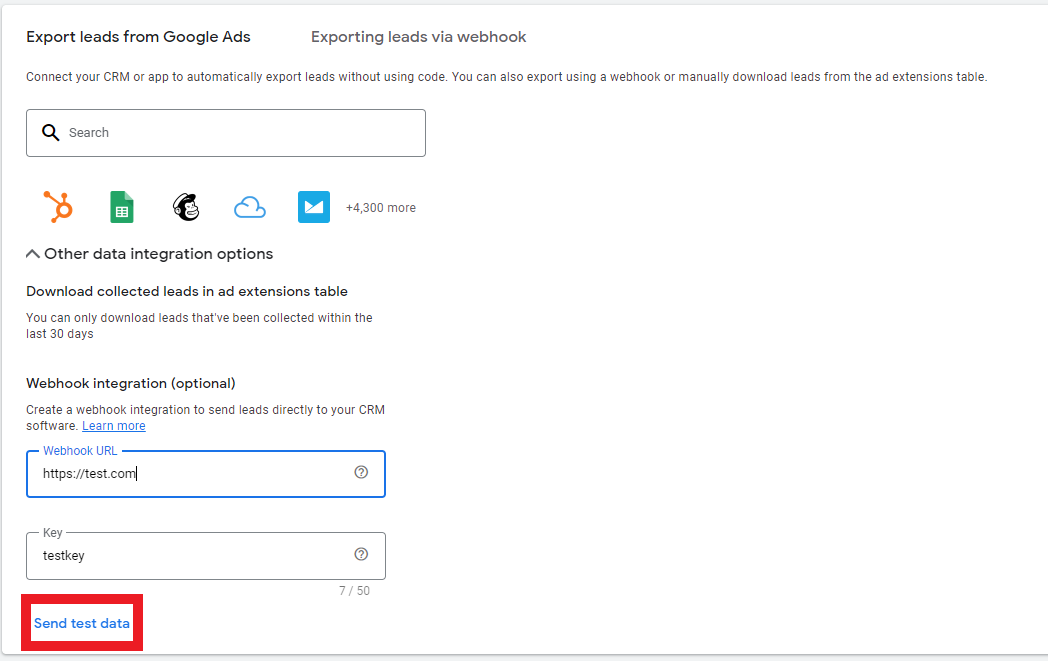 Screenshot taken by author, Google Ads, June 2023.
Screenshot taken by author, Google Ads, June 2023.Summary
If your company is struggling to see leads flow in due to a poor user experience, give Google Lead Form assets a try.
Because of the vast variety of options, such as using them in Search, Display, YouTube, or Discovery, they’re worth testing out.
By combining Smart Bidding with lead form assets, you may see higher conversion rates and more closed deals by introducing a user to this seamless experience.
More resources:
Featured Image: chaylek/Shutterstock
SEO
OpenAI To Show Content & Links In Response To Queries

OpenAI content deal will enhance ChatGPT with the ability to show real-time content with links in response to queries. OpenAI quietly took steps to gaining more search engine type functionality as part of a content licensing deal that may have positive implications for publishers and SEO.
Content Licensing Deal
OpenAI agreed to content licensing with the Financial Times, a global news organization with offices in London, New York, across continental Europe and Asia.
Content licensing deals between AI organizations and publishers are generally about getting access to high quality training data. The training data is then used by language models to learn connections between words and concepts. This deal goes far beyond that use.
ChatGPT Will Show Direct Quotes With Attribution
What makes this content licensing deal between The Financial Times and OpenAI is that there is a reference to giving attribution to content within ChatGPT.
The announced licensing deal explicitly mentions the use of the licensed content so that ChatGPT could directly quote it and provide links to the licensed content.
Further, the licensing deal is intended to help improve ChatGPT’s “usefulness”, which is vague and can mean many things, but it takes on a slightly different meaning when used in the context of attributed answers.
The Financial Times agreement states that the licensing deal is for use in ChatGPT when it provides “attributed content” which is content with an attribution, commonly a link to where the content appeared.
This is the part of the announcement that references attributed content:
“The Financial Times today announced a strategic partnership and licensing agreement with OpenAI, a leader in artificial intelligence research and deployment, to enhance ChatGPT with attributed content, help improve its models’ usefulness by incorporating FT journalism, and collaborate on developing new AI products and features for FT readers. “
And this is the part of the announcement that mentions ChatGPT offering users attributed quotes and links:
“Through the partnership, ChatGPT users will be able to see select attributed summaries, quotes and links to FT journalism in response to relevant queries.”
The Financial Times Group CEO was even more explicit about OpenAI’s intention to show content and links in ChatGPT:
“This is an important agreement in a number of respects,” said FT Group CEO John Ridding. “It recognises the value of our award-winning journalism and will give us early insights into how content is surfaced through AI. …this partnership will help keep us at the forefront of developments in how people access and use information.
OpenAI understands the importance of transparency, attribution, and compensation…”
Brad Lightcap, COO of OpenAI directly referenced showing real-time news content in ChatGPT but more important he referenced OpenAI exploring new ways to show content to its user base.
Lastly, the COO stated that they embraced disruption, which means innovation that creates a new industry or paradigm, usually at the expense of an older one, like search engines.
Lightcap is quoted:
“We have always embraced new technologies and disruption, and we’ll continue to operate with both curiosity and vigilance as we navigate this next wave of change.”
Showing direct quotes of Financial Times content with links to that content is very similar to how search engines work. This is a big change to how ChatGPT works and could be a sign of where ChatGPT is going in the future, a functionality that incorporates online content with links to that content.
Something Else That Is Possibly Related
Someone on Twitter recently noticed a change that is related to “search” in relation to ChatGPT.
This change involves an SSL security certificate that was added for a subdomain of ChatGPT.com. ChatGPT.com is a domain name that was snapped up by someone to capitalize on the 2022 announcement of ChatGPT by OpenAI. OpenAI eventually acquired the domain and it’s been redirecting to ChatGPT.
The change that was noticed is to the subdomain: search.chatgpt.com.
This is a screenshot of the tweet:
Big News For SEO and Publishers
This is significant news for publishers and search marketers ChatGPT will become a source of valuable traffic if OpenAI takes ChatGPT in the direction of providing attributed summaries and direct quotes.
How Can Publishers Get Traffic From ChatGPT?
Questions remain about attributed quotes with links in response to relevant queries. Here are X unknowns about ChatGPT attributed links.
- Does this mean that only licensed content will be shown and linked to in ChatGPT?
- Will ChatGPT incorporate and use most web data without licensing deals in the same way that search engines do?
- OpenAI may incorporate an Opt-In model where publishers can use a notation in Robots.txt or in meta data to opt-in to receiving traffic from ChatGPT.
- Would you opt into receiving traffic from ChatGPT in exchange for allowing your content to be used for training?
- How would SEOs and publisher’s equation on ChatGPT change if their competitors are all receiving traffic from ChatGPT?
Read the original announcement:
Financial Times announces strategic partnership with OpenAI
Featured Image by Shutterstock/Photo For Everything
SEO
Google’s John Mueller On Website Recovery After Core Updates

John Mueller, a Google Search Advocate, provided guidance this week regarding the path forward for websites impacted by recent search algorithm updates.
The discussion started on X (formerly Twitter) by SEO professional Thomas Jepsen.
Jepsen tagged Mueller, asking:
“Google has previously said Google doesn’t hold a grudge and sites will recover once issues have been solved. Is that still the case after HCU?”
Mueller’s response offered hope to site owners while being realistic about the challenges ahead.
Addressing Recovery Timelines
Mueller affirmed Google’s stance on not holding grudges, stating, “That’s still the case.”
However, he acknowledged the complexity of rankings, saying:
“…some things take much longer to be reassessed (sometimes months, at the moment), and some bigger effects require another update cycle.”
That’s still the case. That said, some things take much longer to be reassessed (sometimes months, at the moment), and some bigger effects require another update cycle. https://t.co/WDy7Q4dpzb has some more.
— John 🧀 … 🧀 (@JohnMu) April 29, 2024
Mueller pointed to a Google help document explaining the nuances. The document reads:
“Broad core updates tend to happen every few months. Content that was impacted in Search or Discover by one might not recover—assuming improvements have been made—until the next broad core update is released.
Do keep in mind that improvements made by site owners aren’t a guarantee of recovery, nor do pages have any static or guaranteed position in our search results. If there’s more deserving content, that will continue to rank well with our systems.”
The Comments Sparking Debate
Jepsen probed further, asking, “Is a core update what’s needed for HCU-affected sites to recover (assuming they’ve fixed their issues)?”
Mueller’s response highlighted how situations can differ:
“It depends on the situation… I realize there’s a big space between the situations, but generalizing doesn’t help. Sometimes it takes a lot of work on the site, a long time, and an update.”
It depends on the situation. https://t.co/F9s3Hli9t7 and https://t.co/pLdm29PjPD has some on that. I realize there’s a big space between the situations, but generalizing doesn’t help. Sometimes it takes a lot of work on the site, a long time, and an update.
— John 🧀 … 🧀 (@JohnMu) April 29, 2024
The thread grew as user @selectgame raised concerns about Google Discover traffic, to which Mueller replied:
“Google Discover is affected by core updates as well as other parts of Search (and there are more policies that apply to Discover).”
Google Discover is affected by core updates as well as other parts of Search (and there are more policies that apply to Discover). If you’re seeing these changes when a core update rolled out, that might be what you’re seeing.
— John 🧀 … 🧀 (@JohnMu) April 29, 2024
Growing Frustrations
Prominent industry figure Lily Ray voiced mounting frustrations, stating,
“…many HCU-affected websites – which have been making all kinds of improvements over the last 7 months – have only seen further declines with the March Core Update.
I have seen some sites lose 90% or more of their SEO visibility since the HCU, with the last few weeks being the nail in the coffin, despite making significant improvements.”
Ray continued:
“And in my professional opinion, many of these sites did not deserve anywhere near that level of impact, especially the further declines over the past month.”
Mueller hasn’t responded to Ray’s tweet at this time.
John, any chance you can comment on the fact that many HCU-affected websites – which have been making all kinds of improvements over the last 7 months – have only seen further declines with the March Core Update?
I have seen some sites lose 90% or more of their SEO visibility… https://t.co/lvYRAScRQQ
— Lily Ray 😏 (@lilyraynyc) April 29, 2024
Looking Ahead
As the search community awaits Google’s next moves, the path to recovery appears arduous for many impacted by recent algorithm reassessments of “Helpful Content.”
Site improvements don’t guarantee immediate recovery, so publishers face an uphill battle guided only by Google’s ambiguous public advice.
Why SEJ Cares
The March 2024 core update has proven disastrous for many websites, with severe traffic losses persisting even after sites try to improve low-quality content, address technical issues, and realign with Google’s guidelines.
Having clear, actionable guidance from Google on recovering from core update updates is invaluable.
As evidenced by the frustrations expressed, the current communications leave much to be desired regarding transparency and defining a straightforward recovery path.
How This Can Help You
While Mueller’s comments provide some insights, the key takeaways are:
- Regaining previous rankings after an algorithm hit is possible if sufficient content/site quality improvements are made.
- Recovery timelines can vary significantly and may require a future core algorithm update.
- Even with enhancements, recovery isn’t guaranteed as rankings depend on the overall pool of competing content.
The path is undoubtedly challenging, but Mueller’s comments underscore that perseverance with substantial site improvements can eventually pay off.
FAQ
Can SEO professionals predict recovery time for a website hit by core updates?
SEO professionals can’t pinpoint when a site will recover after a core Google algorithm update.
Reasons for this include:
- Google releases core updates every few months, so sites may need to wait for the next one.
- It can take months for Google to reassess and adjust rankings.
- How competitive the query is also impacts if and when a site recovers.
Does making site improvements after a core update ensure recovery in rankings and visibility?
After making improvements following a Google algorithm update, regaining your previous rankings isn’t guaranteed.
Reasons why include:
- Your impacted content may not recover until the next core update, provided you’ve implemented enough site improvements.
- Google’s search results are dynamic, and rankings can fluctuate based on the quality of competitor content.
- There’s no fixed or guaranteed position in Google’s search results.
What is the relationship between Google Discover traffic and core search updates?
Google’s core algorithm updates that impact regular search results also affect Google Discover.
However, Google Discover has additional specific policies that determine what content appears there.
This means:
- Improving your content and website quality can boost your visibility on Google Discover, just like regular searches.
- You may see changes in your Discover traffic when Google rolls out core updates.
- Your SEO and content strategy should account for potential impacts on regular searches and Google Discover.
Featured Image: eamesBot/Shutterstock
SEO
5 Things To Consider Before A Site Migration

One of the scariest SEO tasks is a site migration because the stakes are so high and the pitfalls at every step . Here are five tips that will help keep a site migration on track to a successful outcome.
Site Migrations Are Not One Thing
Site Migrations are not one thing, they are actually different scenarios and the only thing they have in common is that there is always something that can go wrong.
Here are examples of some of the different kinds of site migrations:
- Migration to a new template
- Migrating to a new web host
- Merging two different websites
- Migrating to a new domain name
- Migrating to a new site architecture
- Migrating to a new content management system (CMS)
- Migrating to a new WordPress site builder
There are many ways a site can change and more ways for those changes to result in a negative outcome.
The following is not a site migration checklist. It’s five suggestions for things to consider.
1. Prepare For Migration: Download Everything
Rule number one is to prepare for the site migration. One of my big concerns is that the old version of the website is properly documented.
These are some of the ways to document a website:
- Download the database and save it in at least two places. I like to have a backup of the backup stored on a second device.
- Download all the website files. Again, I prefer to save a backup of the backup stored on a second device.
- Crawl the site, save the crawl and export it as a CSV or an XML site map. I prefer to have redundant backups just in case something goes wrong.
An important thing to remember about downloading files by FTP is that there are two formats for downloading files: ASCII and Binary.
- Use ASCII for downloading files that contain code, like CSS, JS, PHP and HTML.
- Use Binary for media like images, videos and zip files.
Fortunately, most modern FTP software have an automatic setting that should be able to distinguish between the two kinds of files. A sad thing that can happen is to download image files using the ASCII format which results in corrupted images.
So always check that your files are all properly downloaded and not in a corrupted state. Always consider downloading a copy for yourself if you have hired a third party to handle the migration or a client is doing it and they’re downloading files. That way if they fail with their download you’ll have an uncorrupted copy backed up.
The most important rule about backups: You can never have too many backups!
2. Crawl The Website
Do a complete crawl of the website. Create a backup of the crawl. Then create a backup of the backup and store it on a separate hard drive.
After the site migration, this crawl data can be used to generate a new list for crawling the old URLs to identify any URLs that are missing (404), are failing to redirect, or are redirecting to the wrong webpage. Screaming Frog also has a list mode that can crawl a list of URLs saved in different formats, including as an XML sitemap, and directly input into a text field. This is a way to crawl a specific batch of URLs as opposed to crawling a site from link to to link.
3. Tips For Migrating To A New Template
Website redesigns can be can be a major source of anguish when they go wrong. On paper, migrating a site to a new template should be a one-to-one change with minimal issues. In practice that’s not always the case. For one, no template can be used off the shelf, it has to be modified to conform to what’s needed, which can mean removing and/or altering the code.
Search marketing expert Nigel Mordaunt (LinkedIn), who recently sold his search marketing agency, has experience migrating over a hundred sites and has important considerations for migrating to a new WordPress template.
This is Nigel’s advice:
“Check that all images have the same URL, alt text and image titles, especially if you’re using new images.
Templates sometimes have hard-coded heading elements, especially in the footer and sidebars. Those should be styled with CSS, not with H tags. I had this problem with a template once where the ranks had moved unexpectedly, then found that the Contact Us and other navigation links were all marked up to H2. I think that was more of a problem a few years ago. But still, some themes have H tags hard coded in places that aren’t ideal.
Make sure that all URLs are the exact same, a common mistake. Also, if planning to change content then check that the staging environment has been noindexed then after the site goes live make sure that the newly uploaded live site no longer contains the noindex robots meta tag.
If changing content then be prepared the site to perhaps be re-evaluated by Google. Depending on the size of the site, even if the changes are positive it may take several weeks to be rewarded, and in some cases several months. The client needs to be informed of this before the migration.
Also, check that analytics and tracking codes have been inserted into the new site, review all image sizes to make sure there are no new images that are huge and haven’t been scaled down. You can easily check the image sizes and heading tags with a post-migration Screaming Frog crawl. I can’t imagine doing any kind of site migration without Screaming Frog.”
4. Advice For Migrating To A New Web Host
Mark Barrera (LinkedIn), VP SEO, Newfold Digital (parent company of Bluehost), had this to say about crawling before a site migration in preparation for a migration to a new web host:
“Thoroughly crawl your existing site to identify any indexing or technical SEO issues prior to the move.
Maintain URL Structure (If Possible): Changing URL structures can confuse search engines and damage your link equity. If possible, keep your URLs the same.
301 Redirects: 301 Redirects are your friend. Search engines need to be informed that your old content now lives at a new address. Implementing 301 redirects from any old URLs to their new counterparts preserves link equity and avoids 404 errors for both users and search engine crawlers.
Performance Optimization: Ensure your new host provides a fast and reliable experience. Site speed is important for user experience.
Be sure to do a final walkthrough of your new site before doing your actual cutover. Visually double-check your homepage, any landing pages, and your most popular search hits. Review any checkout/cart flows, comment/review chains, images, and any outbound links to your other sites or your partners.
SSL Certificate: A critical but sometimes neglected aspect of hosting migrations is the SSL certificate setup. Ensuring that your new host supports and correctly implements your existing SSL certificate—or provides a new one without causing errors is vital. SSL/TLS not only secures your site but also impacts SEO. Any misconfiguration during migration can lead to warnings in browsers, which deter visitors and can temporarily impact rankings.
Post migration, it’s crucial to benchmark server response times not just from one location, but regionally or globally, especially if your audience is international. Sometimes, a new hosting platform might show great performance in one area but lag in other parts of the world. Such discrepancies can affect page load times, influencing bounce rates and search rankings. “
5. Accept Limitations
Ethan Lazuk, SEO Strategist & Consultant, Ethan Lazuk Consulting, LLC, (LinkedIn, Twitter) offers an interesting perspective on site migrations on the point about anticipating client limitations imposed upon what you are able to do. It can be frustrating when a client pushes back on advice and it’s important to listen to their reasons for doing it.
I have consulted over Zoom with companies whose SEO departments had concerns about what an external SEO wanted to do. Seeking a third party confirmation about a site migration plan is a reasonable thing to do. So if the internal SEO department has concerns about the plan, it’s not a bad idea to have a trustworthy third party take a look at it.
Ethan shared his experience:
“The most memorable and challenging site migrations I’ve been a part of involved business decisions that I had no control over.
As SEOs, we can create a smart migration plan. We can follow pre- and post-launch checklists, but sometimes, there are legal restrictions or other business realities behind the scenes that we have to work around.
Not having access to a DNS, being restricted from using a brand’s name or certain content, having to use an intermediate domain, and having to work days, weeks, or months afterward to resolve any issues once the internal business situations have changed are just a few of the tricky migration issues I’ve encountered.
The best way to handle these situations require working around client restrictions is to button up the SEO tasks you can control, set honest expectations for how the business issues could impact performance after the migration, and stay vigilant with monitoring post-launch data and using it to advocate for resources you need to finish the job.”
Different Ways To Migrate A Website
Site migrations are a pain and should be approached with caution. I’ve done many different kinds of migrations for myself and have assisted them with clients. I’m currently moving thousands of webpages from a folder to the root and it’s complicated by multiple redirects that have to be reconfigured, not looking forward to it. But migrations are sometimes unavoidable so it’s best to step up to it after careful consideration.
Featured Image by Shutterstock/Krakenimages.com
-

 MARKETING6 days ago
MARKETING6 days agoEffective Communication in Business as a Crisis Management Strategy
-

 SEARCHENGINES7 days ago
SEARCHENGINES7 days agoGoogle Won’t Change The 301 Signals For Ranking & SEO
-

 SEO6 days ago
SEO6 days agobrightonSEO Live Blog
-

 PPC7 days ago
PPC7 days ago9 Ecommerce Trends to Boost Your Business in 2024
-

 SEO4 days ago
SEO4 days agoGoogle March 2024 Core Update Officially Completed A Week Ago
-

 SEO7 days ago
SEO7 days agoHow To Write ChatGPT Prompts To Get The Best Results
-
SEARCHENGINES5 days ago
Daily Search Forum Recap: April 25, 2024
-
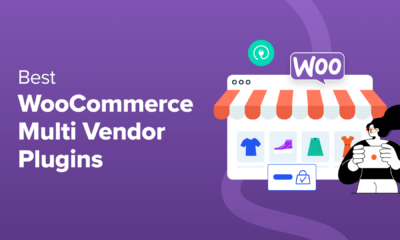
 WORDPRESS5 days ago
WORDPRESS5 days ago9 Best WooCommerce Multi Vendor Plugins (Compared)















